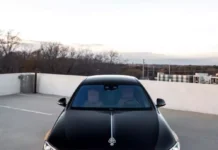Feeling Annoyed While Waiting at the Red Light
Having to wait for too long at a traffic signal can cause an unpleasant feeling for drivers.
A recent study from the UK has shown that the time spent waiting at red lights accounts for one-fifth of the total time spent in traffic for an average person.

If the waiting time at red lights can be reduced, commuters in Asian countries can save up to 75 hours a year to spend on more productive activities.
Ford truly believes that in the future, drivers can use modern technologies to reduce waiting time at red lights and save time on the road. This technology promises significant changes in the daily commuting experience for Asian drivers who often have to spend up to 20 minutes waiting at red lights.
Ford’s technology team is currently testing a vehicle-to-infrastructure (V2i) system that allows vehicles to connect with traffic infrastructure. This technology is being deployed in test areas, including Shanghai. In these areas, the transportation infrastructure system will share real-time traffic data with participating vehicles.

Thomas Lukaszewicz, Manager of Autonomous Vehicle Grive Technologies at Ford Motor Company in Europe and China, said: “Imagine how your life can change when you no longer have to spend time waiting at red lights. Vehicle-to-infrastructure technology holds the promise of making your commute faster and more comfortable.”
Optimum Speed Advisory System
If implemented in the future, Ford will equip its vehicles with the Optimum Speed Advisory System (TLOSA). This system will provide real-time traffic information about upcoming routes and recommend appropriate speeds for drivers to maintain, thus reducing waiting time at red lights during their commute.
Ford’s test vehicles will be equipped with reception and transmission devices inside the vehicle to relay TLOSA information to drivers through voice alerts or a display screen.

The TLOSA system operates based on roadside monitoring devices and signal transmitters integrated into traffic lights and signs. These devices continuously collect and update traffic conditions at key intersections. The TLOSA system uses this data to calculate the suitable driving speed to reduce waiting time at red lights, making your commute easier.

By investing in the development of driver assistance technologies, Ford is committed to improving the quality of life for people. The TLOSA system, along with technologies such as parallel parking assist, lane-keeping assist, and speed control, demonstrates Ford’s efforts to fulfill its commitment.
Lukaszewicz said: “We believe that customers will love this technology. Imagine how many things you could do instead of spending time waiting at red lights at intersections.”
If widely implemented, V2i technology will significantly minimize traffic congestion by intelligently regulating vehicle flow.
Lukaszewicz believes: “With support from car manufacturers and road management agencies, this technology will bring tremendous benefits to commuters.”
anhduc_car (forum.autodaily.vn)







































![[CAR REVIEW] What do users say after using a Toyota Hybrid for a while?](https://vnauto.net/wp-content/uploads/2023/11/Xehay_Toyotahybrid_220823_4-100x70.jpg)

